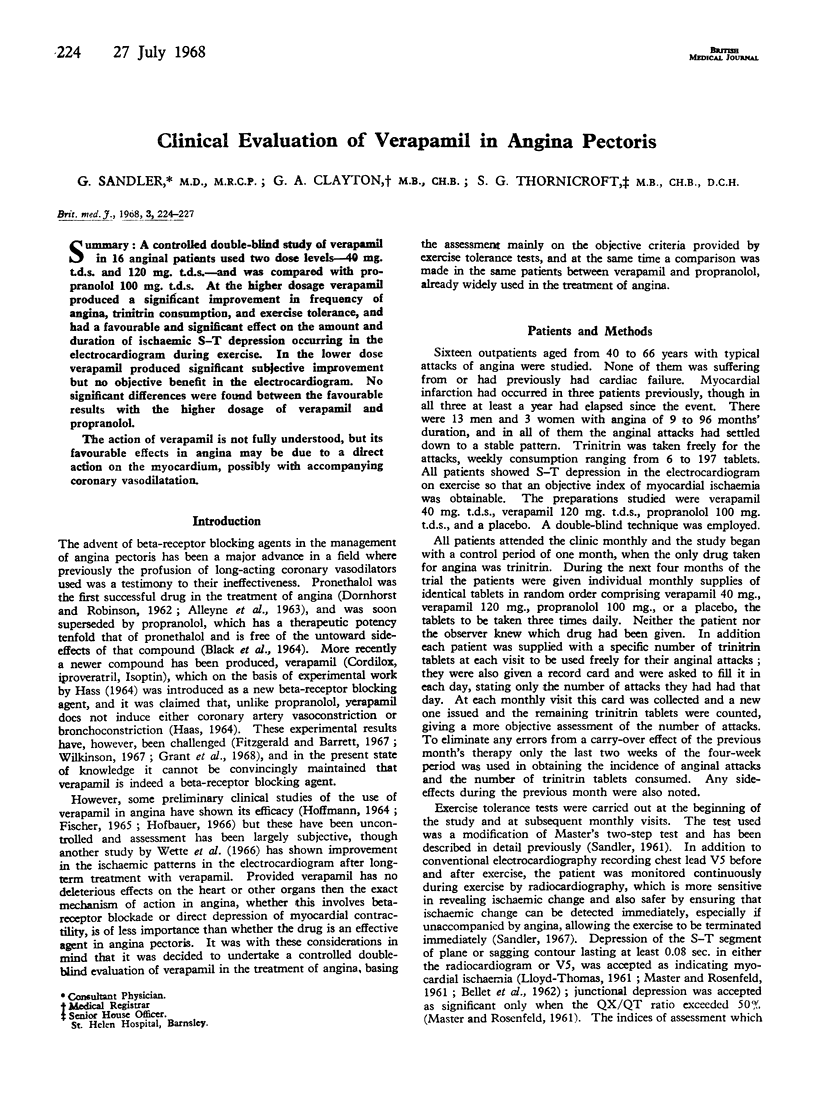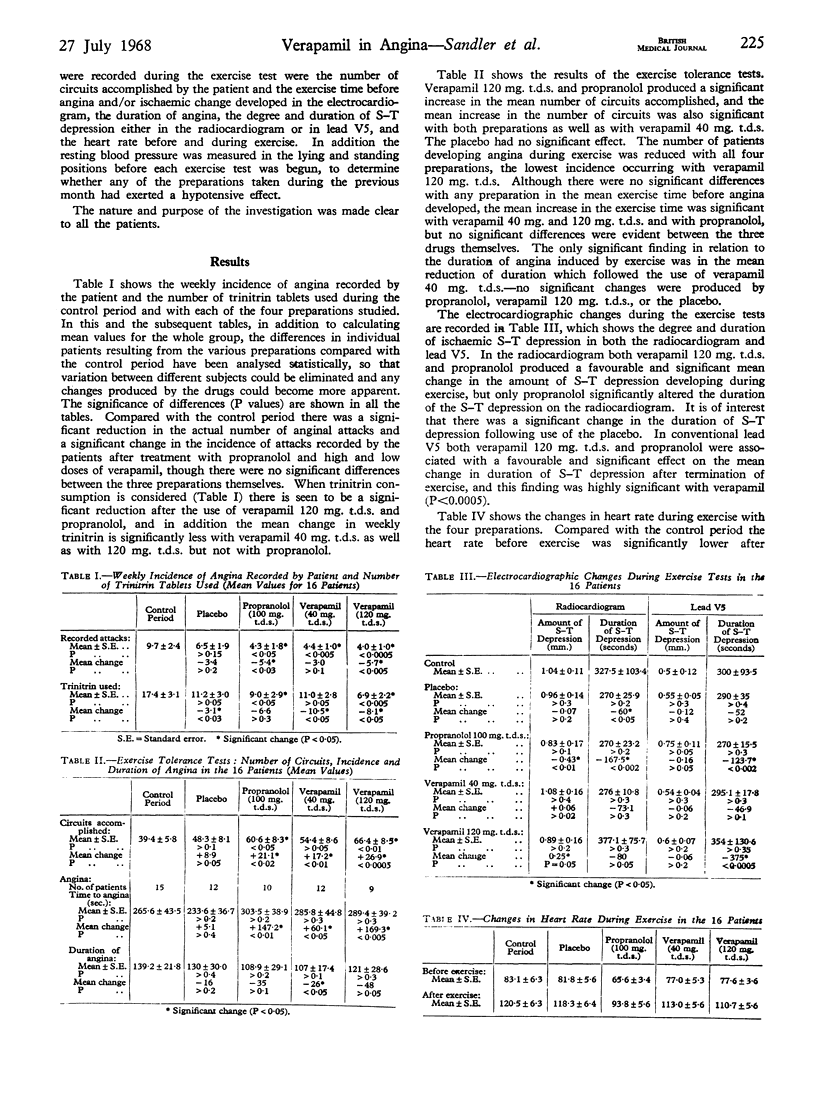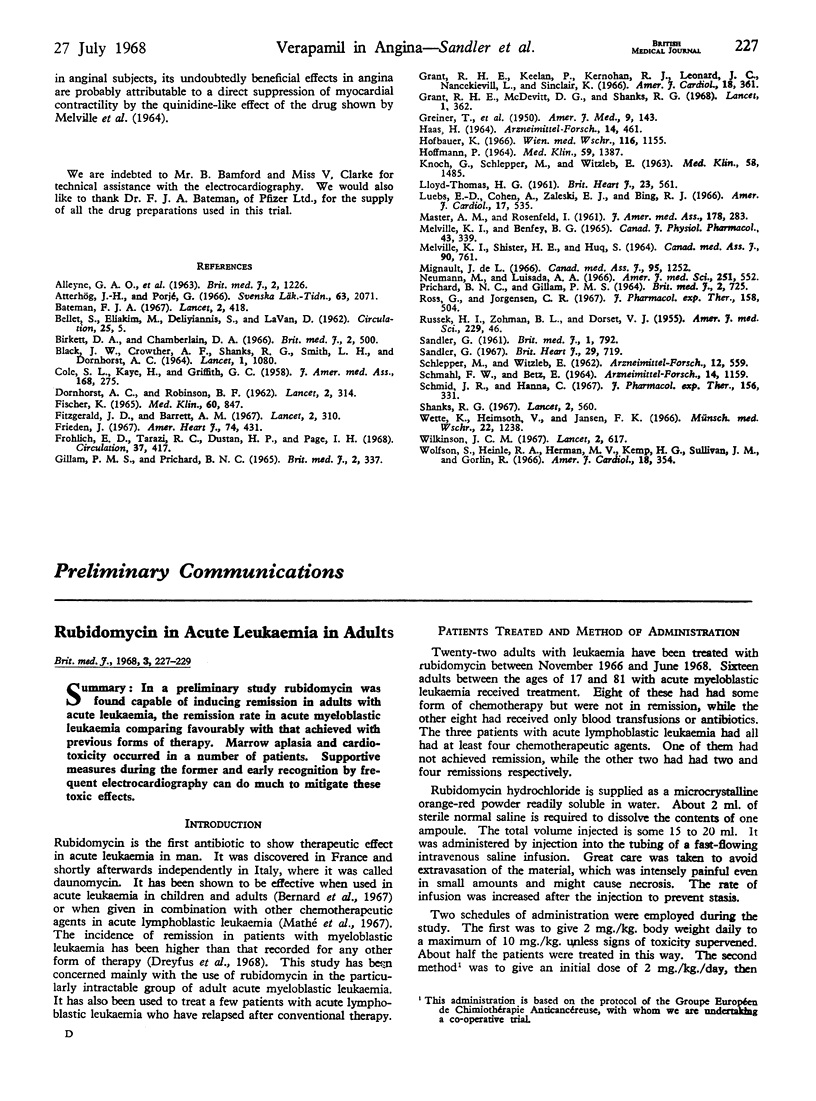Abstract
A controlled double-blind study of verapamil in 16 anginal patients used two dose levels—40 mg. t.d.s. and 120 mg. t.d.s.—and was compared with propranolol 100 mg. t.d.s. At the higher dosage verapamil produced a significant improvement in frequency of angina, trinitrin consumption, and exercise tolerance, and had a favourable and significant effect on the amount and duration of ischaemic S–T depression occurring in the electrocardiogram during exercise. In the lower dose verapamil produced significant subjective improvement but no objective benefit in the electrocardiogram. No significant differences were found between the favourable results with the higher dosage of verapamil and propranolol.
The action of verapamil is not fully understood, but its favourable effects in angina may be due to a direct action on the myocardium, possibly with accompanying coronary vasodilatation.
Full text
PDF



Selected References
These references are in PubMed. This may not be the complete list of references from this article.
- BELLET S., ELIAKIM M., DELIYIANNIS S., LAVAN D. Radioelectrocardiography during exercise in patients with angina pectoris. Comparison with the postexercise electrocardiogram. Circulation. 1962 Jan;25:5–14. doi: 10.1161/01.cir.25.1.5. [DOI] [PubMed] [Google Scholar]
- BLACK J. W., CROWTHER A. F., SHANKS R. G., SMITH L. H., DORNHORST A. C. A NEW ADRENERGIC BETARECEPTOR ANTAGONIST. Lancet. 1964 May 16;1(7342):1080–1081. doi: 10.1016/s0140-6736(64)91275-9. [DOI] [PubMed] [Google Scholar]
- Bailar J. C., 3rd Thromboembolism and oestrogen therapy. Lancet. 1967 Sep 9;2(7515):560–560. doi: 10.1016/s0140-6736(67)90529-6. [DOI] [PubMed] [Google Scholar]
- Birkett D. A., Chamberlain D. A. Beta-adrenergic blockade in angina pectoris: a method of treadmill assessment. Br Med J. 1966 Aug 27;2(5512):500–502. doi: 10.1136/bmj.2.5512.500. [DOI] [PMC free article] [PubMed] [Google Scholar]
- COLE S. L., KAYE H., GRIFFITH G. C. Assay of antianginal agents; the rapport period. J Am Med Assoc. 1958 Sep 20;168(3):275–277. doi: 10.1001/jama.1958.63000030006011b. [DOI] [PubMed] [Google Scholar]
- DORNHORST A. C., ROBINSON B. F. Clinical pharmacology of a beta-adrenergic-blocking agent (Nethalide). Lancet. 1962 Aug 18;2(7251):314–316. doi: 10.1016/s0140-6736(62)90104-6. [DOI] [PubMed] [Google Scholar]
- FISCHER K. BEITRAG ZUR MEDIKAMENTOESEN BEHANDLUNG DER KORONARINSUFFIZIENZ. Med Klin. 1965 May 21;60:847–851. [PubMed] [Google Scholar]
- Frieden J. Propranolol in the treatment of angina pectoris. Am Heart J. 1967 Sep;74(3):431–433. doi: 10.1016/0002-8703(67)90085-3. [DOI] [PubMed] [Google Scholar]
- Frohlich E. D., Tarazi R. C., Dustan H. P., Page I. H. The paradox of beta-adrenergic blockade in hypertension. Circulation. 1968 Mar;37(3):417–423. doi: 10.1161/01.cir.37.3.417. [DOI] [PubMed] [Google Scholar]
- GILLAM P. M., PRICHARD B. N. USE OF PROPRANOLOL IN ANGINA PECTORIS. Br Med J. 1965 Aug 7;2(5457):337–339. doi: 10.1136/bmj.2.5457.337. [DOI] [PMC free article] [PubMed] [Google Scholar]
- GREINER T., GOLD H., CATTELL M., TRAVELL J., BAKST H., RINZLER S. H., BENJAMIN Z. H., WARSHAW L. J., BOBB A. L., KWIT N. T. A method for the evaluation of the effects of drugs on cardiac pain in patients with angina of effort; a study of khellin (visammin). Am J Med. 1950 Aug;9(2):143–155. doi: 10.1016/0002-9343(50)90017-9. [DOI] [PubMed] [Google Scholar]
- Grant R. H., Keelan P., Kernohan R. J., Leonard J. C., Nancekievill L., Sinclair K. Multicenter trial of propranolol in angina pectoris. Am J Cardiol. 1966 Sep;18(3):361–365. doi: 10.1016/0002-9149(66)90054-3. [DOI] [PubMed] [Google Scholar]
- Grant R. H., McDeritt D. G., Shanks R. G. Is verapamil a beta-blocker? Lancet. 1968 Feb 17;1(7538):362–363. doi: 10.1016/s0140-6736(68)90829-5. [DOI] [PubMed] [Google Scholar]
- HAAS H. ZUM WIRKUNGSMECHANISMUS DES ALPHA-ISOPROPYL-ALPHA- Arzneimittelforschung. 1964 May;14:461–468. [PubMed] [Google Scholar]
- HOFFMANN P. BEHANDLUNG KORONARER DURCHBLUTUNGSSTOERUNGEN MIT ISOPTIN IN DER PRAXIS. Med Klin. 1964 Aug 28;59:1387–1391. [PubMed] [Google Scholar]
- Hamer J., Sowton E. Effects of propranolol on exercise tolerance in angina pectoris. Am J Cardiol. 1966 Sep;18(3):354–360. doi: 10.1016/0002-9149(66)90053-1. [DOI] [PubMed] [Google Scholar]
- Hofbauer K. Zur Behandlung stenokardischer Beschwerden mit Iproveratril. Wien Med Wochenschr. 1966 Dec 24;116(52):1155–1156. [PubMed] [Google Scholar]
- Knoch G., Schlepper M., Witzleb E. Untersuchungen an Gesunden und koronarkranken Patienten mit Isoptin. Med Klin. 1963 Sep 6;58(36):1485–1489. [PubMed] [Google Scholar]
- LLOYD-THOMAS H. G. The exercise electrocardiogram in patients with cardiac pain. Br Heart J. 1961 Sep;23:561–577. doi: 10.1136/hrt.23.5.561. [DOI] [PMC free article] [PubMed] [Google Scholar]
- Luebs E. D., Cohen A., Zaleski E. J., Bing R. J. Effect of nitroglycerin, intensain, isoptin and papaverine on coronary blood flow in man. Measured by the coincidence counting technic and rubidium. Am J Cardiol. 1966 Apr;17(4):535–541. doi: 10.1016/0002-9149(66)90245-1. [DOI] [PubMed] [Google Scholar]
- MASTER A. M., ROSENFELD I. Criteria for the clinical application of the "two-step" exercise test. Obviation of false-negative and false-positive responses. JAMA. 1961 Oct 21;178:283–289. doi: 10.1001/jama.1961.03040420023006. [DOI] [PubMed] [Google Scholar]
- MELVILLE K. I., BENFEY B. G. CORONARY VASODILATORY AND CARDIAC ADRENERGIC BLOCKING EFFECTS OF IPROVERATRIL. Can J Physiol Pharmacol. 1965 Mar;43:339–342. doi: 10.1139/y65-033. [DOI] [PubMed] [Google Scholar]
- MELVILLE K. I., SHISTER H. E., HUQ S. IPROVERATRIL: EXPERIMENTAL DATA ON CORONARY DILATATION AND ANTIARRHYTHMIC ACTION. Can Med Assoc J. 1964 Mar 28;90:761–770. [PMC free article] [PubMed] [Google Scholar]
- Mignault J. D. Coronary cineangiographic study of intravenously administered isoptin. Can Med Assoc J. 1966 Dec 10;95(24):1252–1253. [PMC free article] [PubMed] [Google Scholar]
- Neumann M., Luisada A. A. Double blind evaluation of orally administered iproveratril in patients with angina pectoris. Am J Med Sci. 1966 May;251(5):552–556. doi: 10.1097/00000441-196605000-00008. [DOI] [PubMed] [Google Scholar]
- PRICHARD B. N., DICKINSON C. J., ALLEYNE G. A., HURST P., HILL I. D., ROSENHEIM M. L., LAURENCE D. R. EFFECT OF PRONETHALOL IN ANGINA PECTORIS. Br Med J. 1963 Nov 16;2(5367):1226–1229. doi: 10.1136/bmj.2.5367.1226. [DOI] [PMC free article] [PubMed] [Google Scholar]
- PRICHARD B. N., GILLAM P. M. USE OF PROPRANOLOL (INDERAL) IN TREATMENT OF HYPERTENSION. Br Med J. 1964 Sep 19;2(5411):725–727. doi: 10.1136/bmj.2.5411.725. [DOI] [PMC free article] [PubMed] [Google Scholar]
- RUSSEK H. I., ZOHMAN B. L., DORSET V. J. Objective evaluation of coronary vasodilator drugs. Am J Med Sci. 1955 Jan;229(1):46–54. doi: 10.1097/00000441-195501000-00008. [DOI] [PubMed] [Google Scholar]
- SCHMAHL F. W., BETZ E. DIE WIRKUNG VON ALPHA-ISOPROPYL-ALPHA- Arzneimittelforschung. 1964 Oct;14:1159–1160. [PubMed] [Google Scholar]
- Sandler G. Comparison of radiocardiography and conventional electrocardiography in the exercise tolerance test. Br Heart J. 1967 Sep;29(5):719–724. doi: 10.1136/hrt.29.5.719. [DOI] [PMC free article] [PubMed] [Google Scholar]


